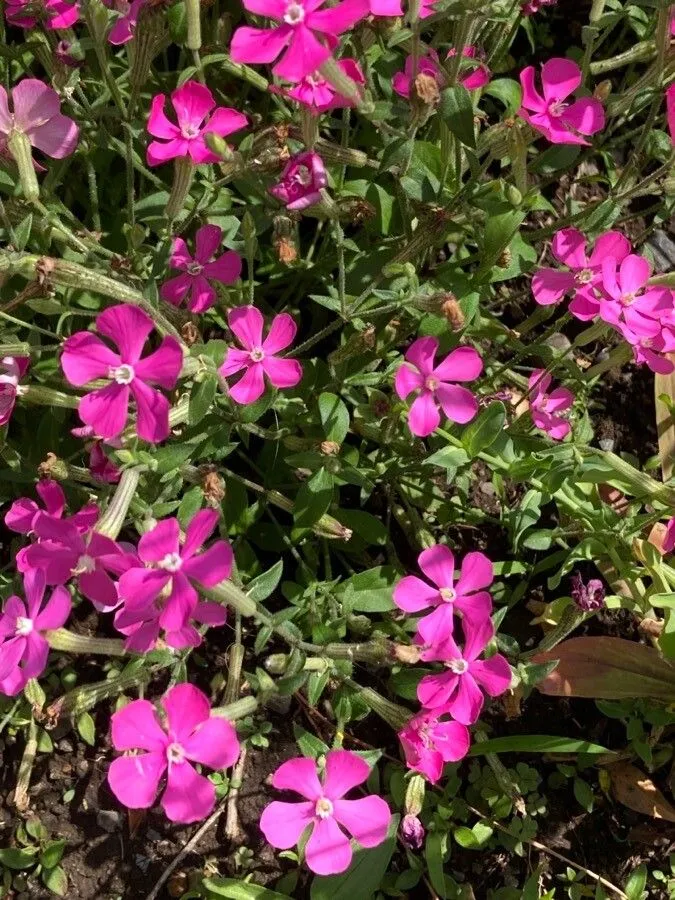
Author: Walter
Bibliography: Fl. Carol.: 142 (1788)
Year: 1788
Status: accepted
Rank: species
Genus: Silene
Vegetable: False
Observations: E. U.S.A.
Wild pink, known scientifically as Silene caroliniana, is an enchanting perennial herb native to the eastern regions of the United States. Described and classified by Walter in 1788, this plant holds a cherished place within the sprawling family of Caryophyllaceae, a group renowned for its ornamental and ecological significance.
Characterized by its vibrant pink blossoms, Wild pink often graces forest glades and road embankments with a splash of color during the blooming season. The flowers, typically blooming from late spring to early summer, are composed of several deep pink to rose-hued petals that cluster together, creating a dense and vivid display. Each delicate petal is slightly notched at the tip, providing a charmingly ragged appearance that sets the species apart.
The foliage of Silene caroliniana is equally noteworthy. The leaves are typically lanceolate to ovate, presenting a lush green that beautifully complements the striking flowers. This verdant greenery forms a dense basal rosette, from which slender stems rise, each crowned with a stunning floral display.
Ecologically, Wild pink plays a crucial role in its native habitats. The flowers attract a variety of pollinators, including bees and butterflies, which, in turn, support the broader ecosystem. This makes Silene caroliniana not only a visual asset to its environment but also an important component of the local biodiversity.
The plant thrives best in well-drained, sandy to rocky soils, often found in woodland fringes and open clearings. It is particularly well-suited to gardens that aim to mimic natural landscapes or support pollinator populations, owing to its minimal maintenance needs and its propensity to naturalize in favorable conditions.
Garden enthusiasts and botanists alike treasure Wild pink for its resilient nature and the serene beauty it introduces to both managed gardens and wild settings. Whether cherished for its ecological contributions or its ornamental allure, Silene caroliniana continues to be celebrated and preserved across its native range.
Eng: sticky catchfly
En: Wild pink, Sticky catchfly
Taken Jan 1, 1900 by EOL − Smithsonian Institution, National Museum of Natural History, Department of Botany (cc-by-nc-sa)
Taken Jan 1, 1900 by EOL − Smithsonian Institution, National Museum of Natural History, Department of Botany (cc-by-nc-sa)
Taken Apr 22, 2013 by EOL − James Shelton (cc-by-nc-sa)
Taken Apr 20, 2013 by EOL − James Shelton (cc-by-nc-sa)
Taken Apr 22, 2020 by k m (cc-by-sa)
Taken Apr 22, 2022 by 道草 (cc-by-sa)
Growth habit>: Forb/herb
Family: Myrtaceae Author: (F.Muell.) K.D.Hill & L.A.S.Johnson Bibliography: Telopea 6: 402 (1995) Year: 1995 Status:…
Family: Rubiaceae Author: Pierre ex A.Froehner Bibliography: Notizbl. Bot. Gart. Berlin-Dahlem 1: 237 (1897) Year:…
Family: Sapindaceae Author: Koidz. Bibliography: J. Coll. Sci. Imp. Univ. Tokyo 32(1): 38 (1911) Year:…
Family: Asteraceae Author: A.Gray Bibliography: Pacif. Railr. Rep.: 107 (1857) Year: 1857 Status: accepted Rank:…
Family: Fabaceae Author: Medik. Bibliography: Vorles. Churpfälz. Phys.-Ökon. Ges. 2: 398 (1787) Year: 1787 Status:…
Family: Aspleniaceae Author: (Cav.) Alston Bibliography: Bull. Misc. Inform. Kew 1932: 309 (1932) Year: 1932…